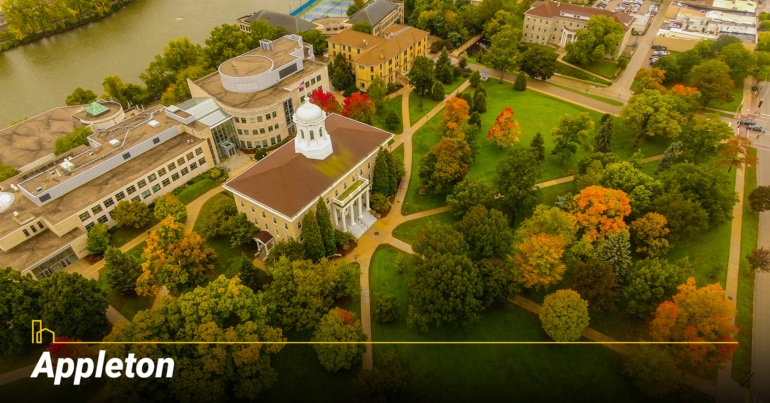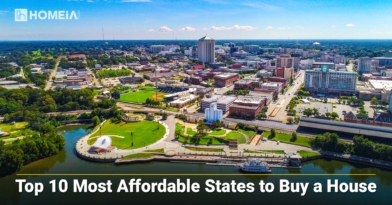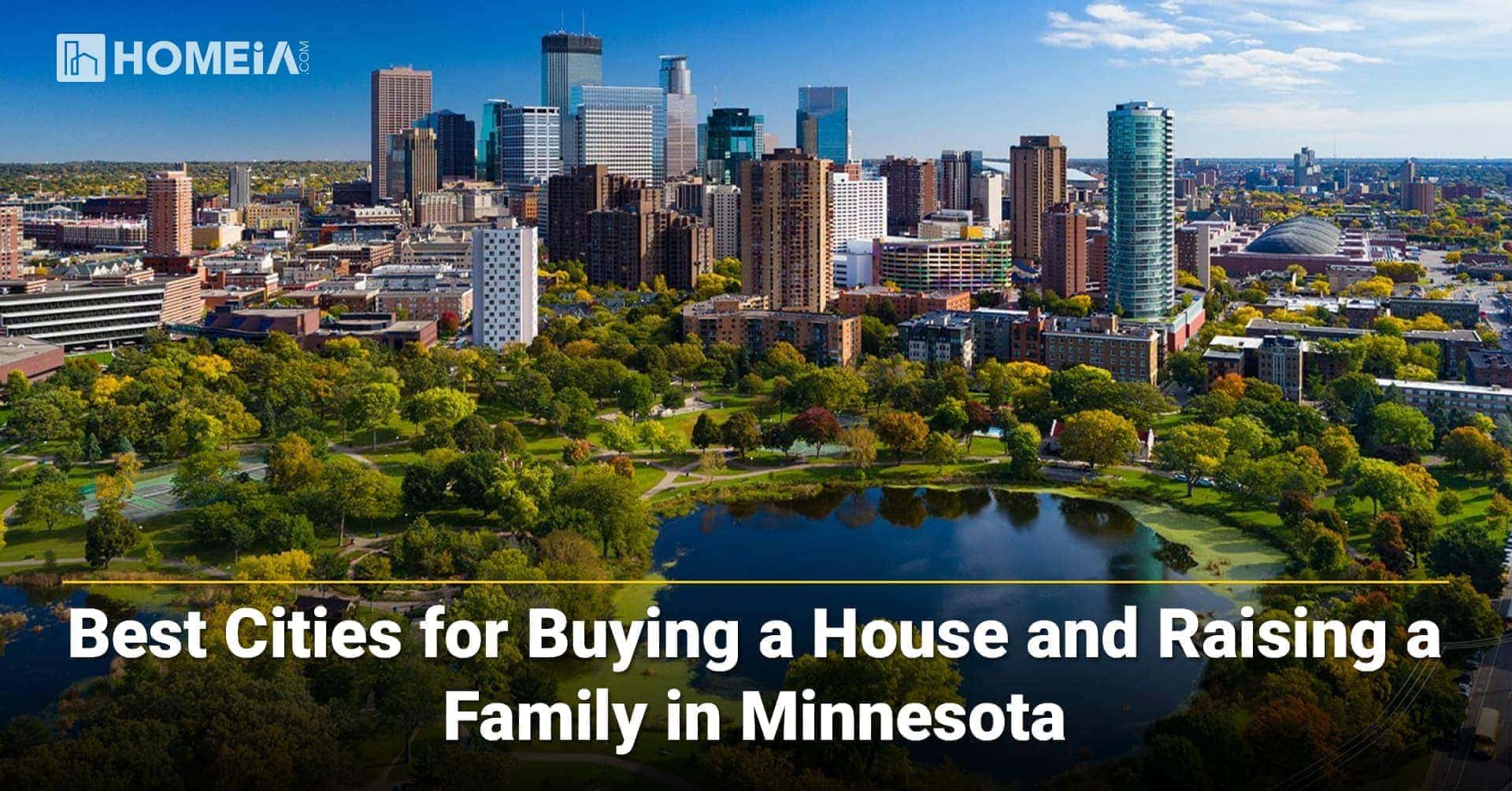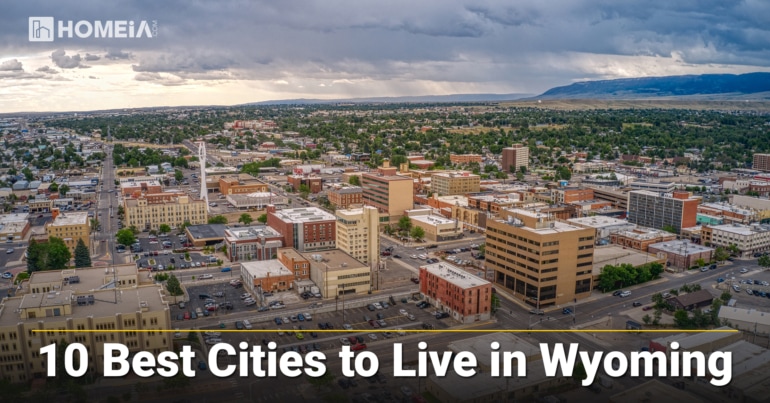10 Best Places to Live in Wisconsin
- Author:by The HOMEiA Team
- Category: City Living Guide
Wisconsin is a friendly and casual place to enjoy all four seasons. Best known for its dairy farms and pro sports, it is also home to tech companies and a world-class research university.
Most of the landscape is sparsely populated countryside, dotted with thousands of lakes. But while over half of Wisconsinites live in towns of fewer than 20,000, there are also cities to enjoy. The biggest, Milwaukee, has a larger population than Baltimore or Atlanta.
All of the communities described below have certain characteristics in common. Here are a few:
- 1. Taxes: Wisconsin has a progressive state income tax that ranges from 3.54% to 7.65%. The national average state income tax is 4.6%. The state and local sales tax combined rate ranges from 5.0% to 5.5%, below the national average of 6.2%. Wisconsin has a relatively high effective property tax rate of 1.68%.
- 2. Climate: Most of Wisconsin is cold and snowy in the winter and hot and humid in the summer. We will mention any specific climatic anomalies for specific areas if they exist.
The 10 best places to live in Wisconsin
Table of Contents:
1. Madison, WI
HOMEiA Score: 93/100
- Population: 269,840 | Rank Last Year: #1
- Cost of Living: 1% above the U.S. national average
- Home price to income ratio: $246,300/$65,332 = 3.77 (buying homes is affordable)
- Income to rent ratio: $65,332/$13,416 = 4.87 (renting homes is affordable)
Madison, the state capital, is centered on an isthmus between two lakes in the south-central part of the state. Madison is one of best cities to live in Wisconsin in 2022. It is served by the Dane County Regional Airport and is crossed by Interstate 39/90 from north to south and I-94 from east to west.
MADISON MEDIAN HOUSEHOLD INCOME (2019): $65,332
Madison Cost of Living.
- 1% Above the U.S. National Average
- 19% Higher than Milwaukee, Wisconsin
- 40% Lower than New York City, New York
- 6% Lower than Chicago, Illinois
Madison Housing Costs
| Median Home Value | Annual Spend for Homeowners | Annual Spend for Renters (Rent & Utilities) |
| $246,300 | $21,012 | $13,416 |
The 15 Best Places to Live & Retire in Minnesota
The cost of living in Minnesota varies by location and is highest in its large metro areas, but on the whole, it compares well to the coasts and to big cities. Each community in Minnesota has its own personality, and here we will introduce you to 15 of the best options for retiring in the North Star State…
2. Milwaukee, WI
HOMEiA Score: 86/100
- Population: 577,222 | Rank Last Year: #7
- Cost of Living: 15% below the U.S. national average
- Home price to income ratio: $122,100/$41,838 = 2.92 (buying homes is very affordable)
- Income to rent ratio: $41,838/$10,296 = 4.06 (renting homes is affordable)
Milwaukee is located in southeastern Wisconsin, just north of Chicago along the shore of Lake Michigan. General Mitchell International Airport is the major hub for air travel in the state.
MILWAUKEE MEDIAN HOUSEHOLD INCOME (2019): $41,838
Milwaukee Cost of Living.
- 15% Lower the U.S. National Average
- 16% Lower than Madison, Wisconsin
- 50% Lower than New York City, New York
- 21% Lower than Chicago, Illinois
Milwaukee Housing Costs
| Median Home Value | Annual Spend for Homeowners | Annual Spend for Renters (Rent & Utilities) |
| $122,100 | $15,576 | $10,296 |
Recommended for you
3. Eau Claire
HOMEiA Score: 91/100
- Population: 69,421 | Rank Last Year: #3
- Cost of Living: 11% below the U.S. National Average
- Home price to income ratio: $155,000/$55,477 = 2.79 (buying homes is very affordable)
- Income to rent ratio: $55,477/$10,020 = 5.54 (renting homes is very affordable)
Eau Claire is found in the western part of Wisconsin, almost due east of Minneapolis. The Chippewa River cuts through the city. Interstate 94 takes drivers west to the Twin Cities or southeast toward Madison.
EAU CLAIRE MEDIAN HOUSEHOLD INCOME (2019): $55,477
Eau Claire Cost of Living, Wisconsin.
- 11% Below the U.S. National Average
- 12% Lower than Madison, Wisconsin
- 47% Lower than New York City, New York
- 17% Higher than Chicago, Illinois
Eau Claire Housing Costs
| Median Home Value | Annual Spend for Homeowners | Annual Spend for Renters (Rent & Utilities) |
| $155,000 | $15,132 | $10,020 |
Recommended for you
4. Green Bay
HOMEiA Score: 85/100
- Population: 107,395 | Rank Last Year: #8
- Cost of Living: 20% below the U.S. national average
- Home price to income ratio: $135,900/$49,251= 2.76 (buying homes is very affordable)
- Income to rent ratio: $49,251/$8,760 = 5.62 (renting homes is very affordable)
The city of Green Bay is located at the mouth of the Fox River, as it flows northward from Lake Winnebago and ends at Green Bay. Interstate 41 connects Green Bay to Appleton to the southwest.
Green Bay has a population of 107,395 (2020) spread over a 55.76-square-mile area. The population density is 1,926 per square mile.
The population in Green Bay grew by 3.2% from April 2010 through April 2020, below both the overall U.S. rate of 6.9% and the Wisconsin rate of 3.5%.
GREEN BAY MEDIAN HOUSEHOLD INCOME (2019): $49,251
Green Bay Cost of Living, Wisconsin.
- 20% Below the U.S. National Average
- 5% Lower than Milwaukee, Wisconsin
- 52% Lower than New York City, New York
- 5% Lower than Chicago, Illinois
Green Bay Housing Costs
| Median Home Value | Annual Spend for Homeowners | Annual Spend for Renters (Rent & Utilities) |
| $135,900 | $13,932 | $8,760 |
Recommended for you
5. Janesville
HOMEiA Score: 80/100
- Population: 65,615 | Rank Last Year: #10
- Cost of Living: 15% below the U.S. national average
- Home price to income ratio: $142,500/$56,293 = 2.53 (buying homes is very affordable)
- Income to rent ratio: $56,293/$10,296=5.47 (renting homes is very affordable)
Janesville is located near the southern border of the state, slightly closer to the eastern side than the western side. It is under an hour’s drive from Madison via I-94, and just over an hour from Milwaukee.
JANESVILLE MEDIAN HOUSEHOLD INCOME (2019): $56,293
Janesville Cost of Living, Wisconsin.
- 15% Below the U.S. National Average
- 16% Lower than Madison, Wisconsin
- 50% Lower than New York City, New York
- 21% Lower than Chicago, Illinois
Janesville Housing Costs
| Median Home Value | Annual Spend for Homeowners | Annual Spend for Renters (Rent & Utilities) |
| $142,500 | $14,652 | $10,296 |
4 Best Places to Live in Minnesota for Families in 2024
Bordering Canada and the Great Lakes is a state fondly dubbed as the “North Star State” and “Land of 10,000 Lakes.” The state has a lot of lakes sprawled across its more than 86,000 square mile area. In a comprehensive study of cities, Minnesota is the number one state for raising a family because of its high median income, affordable cost of living and exceptional education services…
6. Wausau
HOMEiA Score: 83/100
- Population: 39,994 | Rank Last Year: #9
- Cost of Living: 19% below the U.S. national average
- Home price to income ratio: $121,900/$46,824 = 2.60 (buying homes is very affordable)
- Income to rent ratio: $46,824/$8,496 = 5.51 (renting homes is very affordable)
Wausau is just north of the center of Wisconsin. It is accessible via Interstate 39 north to south and U.S. Highway 29 east to west. The Wisconsin River runs widely through the town.
WAUSAU MEDIAN HOUSEHOLD INCOME (2019): $46,824
Wausau Cost of Living, Wisconsin.
- 19% Below the U.S. National Average
- 20% Lower than Madison, Wisconsin
- 52% Lower than New York City, New York
- 25% Lower than Chicago, Illinois
Wausau Housing Costs
| Median Home Value | Annual Spend for Homeowners | Annual Spend for Renters (Rent & Utilities) |
| $121,900 | $12,912 | $8,496 |
Recommended for you
7. Waunakee
HOMEiA Score: 93/100
- Population: 14,879 | Rank Last Year: #2
- Cost of Living: 12% above the U.S. national average
- Home price to income ratio: $346,300/$112,845 = 3.07 (buying homes is affordable)
- Income to rent ratio: $112,845/$12,156 = 9.28 (renting homes is very affordable)
Waunakee is a suburb located just north of Madison and not far to the west of the Dane County Regional Airport. Six Mile Creek runs through the town.
WAUNAKEE MEDIAN HOUSEHOLD INCOME (2019): $112,845
Waunakee Cost of Living, Wisconsin.
- 12% Above the U.S. National Average
- 11% Higher than Madison, Wisconsin
- 34% Lower than New York City, New York
- 4% Higher than Chicago, Illinois
Waunakee Housing Costs
| Median Home Value | Annual Spend for Homeowners | Annual Spend for Renters (Rent & Utilities) |
| $346,300 | $26,784 | $12,156 |
5 Best Places to Live in Texas
Each of the five large cities described are chock-full of neighborhoods that are favored by families with children, young professionals, and retirees. We’ll focus on eight critical attributes that often define a city: History and population, Lifestyle, Affordability, Housing market and neighborhoods, Healthcare and safety, Employment…
8. Sturgeon Bay
HOMEiA Score: 88/100
- Population: 9,646 | Rank Last Year: #5
- Cost of Living: 18% below the U.S. national average
- Home price to income ratio: $147,000/$57,673 = 2.55 (buying homes is very affordable)
- Income to rent ratio: $57,673/$9,480 = 6.08 (renting homes is very affordable)
Sturgeon Bay is located at the base of the Door Peninsula, which juts out into Lake Michigan and creates Green Bay. The body of water for which the town is named, Sturgeon Bay, divides the town in two. Three bridges (including U.S. Highway 42) connect the halves.
STURGEON BAY MEDIAN HOUSEHOLD INCOME (2019): $57,673
Sturgeon Bay Cost of Living, Wisconsin.
- 18% Below the U.S. National Average
- 4% Higher than Milwaukee, Wisconsin
- 52% Lower than New York City, New York
- 24% Lower than Chicago, Illinois
Sturgeon Bay Housing Costs
| Median Home Value | Annual Spend for Homeowners | Annual Spend for Renters (Rent & Utilities) |
| $147,000 | $13,944 | $9,480 |
Recommended for you
9. Appleton

HOMEiA Score: 90/100
- Population: 75,664 | Rank Last Year: #4
- Cost of Living: 16% below the U.S. national average
- Home price to income ratio: $147,800/$58,112 = 2.54 (buying homes is very affordable)
- Income to rent ratio: $58,112/$9,696 = 5.99 (renting homes is very affordable)
Appleton is one of the Fox Cities, a group of several communities along the Fox River in eastern Wisconsin. It is situated at the north end of Lake Winnebago. Interstate 41 connects Appleton to Milwaukee to the southeast and Green Bay to the northeast.
APPLETON MEDIAN HOUSEHOLD INCOME (2019): $58,112
Appleton Cost of Living.
- 16% Below the U.S. National Average
- 1% Lower Than Milwaukee, Wisconsin
- 50% Lower than New York City, New York
- 22% Lower than Chicago, Illinois
Appleton Housing Costs
| Median Home Value | Annual Spend for Homeowners | Annual Spend for Renters (Rent & Utilities) |
| $147,800 | $14,964 | $9,696 |
15 Best Places to Raise a Family in the US in 2024
When kids enter the picture, those preferences can give way to highly practical: great schools, safe neighborhoods, plenty of young families, and high-quality healthcare. We’ve compiled a list of 15 cities that meet the needs of a growing family—our picks for the most family-friendly cities in the United States…
10. Stoughton
HOMEiA Score: 88/100
- Population: 13,173 | Rank Last Year: #6
- Cost of Living: 3% below the U.S. national average
- Home price to income ratio: $218,100/$67,329 = 3.24 (buying homes is affordable)
- Income to rent ratio: $67,329/$11,316 = 5.95 (renting homes is very affordable)
Stoughton is a small community about a half hour’s drive southeast of Madison. It is located on the Yahara River and just south of Lake Kegonsa. Highway 51 is the main route in and out of town.
STOUGHTON MEDIAN HOUSEHOLD INCOME (2019): $67,329
Stoughton Cost of Living:
- 3% Below the U.S. National Average
- 3% Lower than Madison, Wisconsin
- 42% Lower than New York City, New York
- 10% Lower than Chicago, Illinois
Stoughton Housing Costs
| Median Home Value | Annual Spend for Homeowners | Annual Spend for Renters (Rent & Utilities) |
| $218,100 | $18,660 | $11,316 |
CONCLUSION
Wisconsin may be known for its cheese – and it makes some really great cheese – but it has a lot more to offer residents and visitors. With miles of lakeshore and thick forests, big cities and quaint towns, it is a state with a lot of variety.
10 Most Affordable States to Buy a House in 2024
If you have the flexibility to move anywhere in the U.S., where could you buy the cheapest home? After examining data from Zillow and World Population Review. Here’re 10 most affordable States in the South and the Midwest to consider when buying a house in 2024…




























































